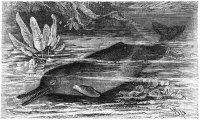 The Indus River dolphin (Platanista minor) is listed as 'endangered', experts/researchers think that there are still (give or take) 1,100 of them. Still, for the record, it is the 2nd most threatened freshwater dolphin, and the decline over the years could be attributed to various causes. Just to mention a few: poaching, water pollution, destruction of their natural habitat and those getting stranded. When the irrigation system of the Indus commenced, the dramatic decline of these dolphins began.
The Indus River dolphin (Platanista minor) is listed as 'endangered', experts/researchers think that there are still (give or take) 1,100 of them. Still, for the record, it is the 2nd most threatened freshwater dolphin, and the decline over the years could be attributed to various causes. Just to mention a few: poaching, water pollution, destruction of their natural habitat and those getting stranded. When the irrigation system of the Indus commenced, the dramatic decline of these dolphins began.Indus River dolphins are recognized by the long beak, circular belly, stocky physique, tiny dorsal fin and the big flippers...and speaking of the eyes, they are called "blind river dolphins", their eyes do not have a lense, yet, just like many of their relatives, echolocation helps them position themselves. (Echolocation is the sound sensory process that makes them capable of locating prey even in the mud).
An Indus River dolphin navigates on one side, they could even move in shallow water, something like 30 centimeters deep. In moving as such, this is how they go: after about half to a full minute, when the Indus River dolphin is running out of breath, it breaks out of the surface. It rotates (upright) to get in oxygen, rotate again by ninety degrees and then return under the surface (a pretty elaborate performance, even for dolphins).

Custom Search